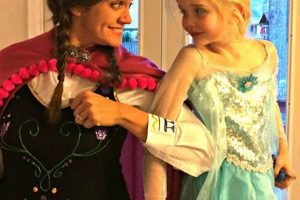A self-assembled pirate outfit represents a creative and cost-effective method for individuals to embody the iconic swashbuckler archetype. This approach often involves repurposing existing clothing items, crafting accessories from readily available materials, and applying personal artistic touches to achieve a unique and personalized aesthetic. For instance, a simple white shirt can be transformed with tattered edges, paired with dark pants or a skirt, and complemented by a homemade eye patch and bandana.
The significance of constructing a pirate-themed ensemble lies in its ability to foster resourcefulness and imagination. This process allows participants to avoid the expense of commercially produced attire, while simultaneously developing their crafting skills. Historically, the romanticized image of pirates has captivated audiences, leading to consistent demand for related apparel, making the capacity to independently create such items a valuable skill for themed events or performances.
The subsequent sections will detail specific techniques for creating core components of a pirate-inspired look, including clothing alterations, accessory construction, and makeup application. These techniques provide readers with practical guidance for assembling a convincing and individualistic presentation.
Tips for Constructing a Pirate-Inspired Ensemble
The following outlines practical considerations for assembling a pirate-themed look using do-it-yourself methods. These guidelines aim to enhance the authenticity and visual appeal of the final product.
Tip 1: Fabric Selection: Prioritize durable, natural fabrics such as linen, cotton, or canvas. These materials offer a historically accurate appearance and withstand the rigors of wear, especially if the garment is intended for outdoor use.
Tip 2: Distressing Techniques: Employ techniques such as tearing, fraying, and staining to create a weathered and battle-worn aesthetic. Coffee or tea can be used to subtly tint fabrics, while strategic rips and tears enhance the appearance of age and wear.
Tip 3: Accessory Procurement: Focus on acquiring or crafting essential accessories. A wide belt, a bandana, and a mock cutlass or sword are crucial elements. These items should complement the color palette and overall design of the ensemble.
Tip 4: Boot Modification: Existing boots can be adapted to resemble period footwear. Adding cuffs, buckles, or faux leather overlays can transform ordinary boots into convincing pirate-style footwear.
Tip 5: Makeup Application: Consider incorporating makeup to enhance the character’s persona. A subtle application of eyeliner and bronzer can create a rugged appearance, while a fake scar or missing tooth can further amplify the pirate aesthetic.
Tip 6: Layering: Layering pieces adds depth and visual interest. A vest over a shirt, combined with a long coat or sash, contributes to a more complex and authentic pirate look. The layering also allows for adjustment to varying weather conditions.
Tip 7: Size and Fit: While a loose and comfortable fit is generally appropriate, ensure that the clothing is not excessively baggy. A well-proportioned garment enhances the overall visual impact and prevents the costume from appearing sloppy.
By adhering to these recommendations, individuals can craft a compelling and visually authentic pirate-themed representation using cost-effective, do-it-yourself methodologies. The key lies in meticulous attention to detail and a focus on conveying the character’s rugged, seafaring lifestyle.
The subsequent conclusion will summarize the principal elements of creating a pirate persona and reiterate the benefits of a self-assembled approach.
1. Adaptable wardrobe
An adaptable wardrobe functions as a foundational element in the creation of a self-assembled pirate outfit. The capacity to utilize and modify existing clothing items directly reduces the need for specialized purchases, thereby lowering the overall cost associated with the project. This principle hinges on the premise that numerous garments can be repurposed through strategic alterations and embellishments. For example, a common button-down shirt, when subjected to fraying, tearing, and the addition of ruffles or cravats, can effectively emulate a period-appropriate pirate blouse.
The importance of wardrobe adaptability extends beyond mere cost-effectiveness. It fosters resourcefulness and creative problem-solving, encouraging individuals to view ordinary items as potential components of a pirate-themed ensemble. A pair of dark trousers can become pirate pants with the simple addition of slits at the knees and decorative stitching. Similarly, a vest, regardless of its original style, can be readily transformed through the application of antiquing techniques and the incorporation of pirate-themed embellishments such as skull and crossbones patches or decorative buttons.
In summary, the connection between an adaptable wardrobe and the creation of a self-assembled pirate outfit is intrinsically linked. The ability to creatively manipulate existing garments not only reduces financial outlay but also stimulates inventive resourcefulness, enabling the construction of a unique and personalized pirate aesthetic. This approach fosters a deeper engagement with the character and promotes sustainable practices by reducing the demand for new, specialized costumes.
2. Resourceful repurposing
Resourceful repurposing constitutes a cornerstone of the self-assembled pirate costume endeavor. It promotes cost-efficiency and creative ingenuity, transforming readily available materials into components of a convincing pirate aesthetic. The practice aligns with historical precedents, reflecting the often makeshift nature of pirate attire.
- Garment Transformation
The modification of existing clothing items into pirate-themed apparel exemplifies resourceful repurposing. A standard button-down shirt can be altered by removing the collar, adding ruffles, and distressing the fabric to simulate wear and tear. Similarly, denim trousers can be cut into breeches or tattered for a rugged appearance. These transformations minimize expenses associated with acquiring new materials and maximize the utility of existing resources.
- Accessory Adaptation
Utilizing household items to fabricate pirate accessories underscores the principle of resourceful repurposing. Cardboard can be fashioned into a tricorn hat, painted, and adorned with found objects. Leather scraps from discarded furniture or clothing can be repurposed into eye patches, belts, or scabbards. These adaptations promote creativity and minimize waste, aligning with a sustainable approach to costume construction.
- Hardware Salvaging
The retrieval and incorporation of disca
rded hardware components contribute to the realism of a self-assembled pirate costume. Buckles from old belts, buttons from thrift store garments, and metal rings from discarded keychains can be used to embellish attire and accessories. These elements impart a sense of authenticity and historical accuracy to the costume, enhancing its overall visual appeal. - Textile Recycling
Reusing textiles from old curtains, bedsheets, or tablecloths to create pirate attire represents a particularly effective application of resourceful repurposing. These materials can be cut and sewn into vests, sashes, or bandanas. Their inherent texture and potential for distressing make them well-suited for simulating the worn and weathered appearance associated with pirate clothing. This approach minimizes environmental impact by diverting textiles from landfills and extending their lifecycle.
The convergence of these resourceful repurposing techniques enables the cost-effective and environmentally conscious creation of a convincing pirate persona. The application of these principles fosters creativity, promotes resourcefulness, and generates a personalized aesthetic, thereby enhancing the overall quality and impact of the self-assembled pirate costume.
3. Distinctive accessories
The incorporation of distinctive accessories represents a pivotal stage in the creation of a self-assembled pirate costume. These elements transcend mere ornamentation; they serve as critical signifiers of character and historical context, imbuing the attire with authenticity and narrative depth.
- Eye Patches
The eye patch, often associated with pirates, functions as a visual marker of injury or battle experience. In the context of self-assembled costumes, eye patches can be constructed from readily available materials like felt, leather scraps, or even repurposed cardboard. The design can be personalized with stitching, embellishments, or faux damage to enhance its visual impact and contribute to the character’s backstory.
- Headwear
Pirate headwear, ranging from bandanas to tricorn hats, serves as a defining characteristic of the ensemble. A simple bandana can be fashioned from fabric scraps and customized with prints or distressed effects. Tricorn hats can be constructed from cardboard or felt, providing a more elaborate and historically evocative element. The choice of headwear directly influences the perceived rank and personality of the pirate character.
- Weaponry (Simulated)
Simulated weaponry, such as swords, daggers, or flintlock pistols, adds a layer of authenticity and visual flair to the costume. These items can be crafted from wood, foam, or repurposed plastic components. Safety considerations are paramount when constructing and handling simulated weapons; sharp edges should be avoided, and materials should be non-toxic. The design of the weaponry can reflect the pirate’s combat style or personal preferences.
- Belts and Sashes
Belts and sashes serve both functional and decorative purposes in pirate attire. They can be constructed from leather, fabric, or rope, and used to secure clothing or carry accessories. Wide belts can be adorned with buckles or pouches, while sashes can be made from colorful fabrics and worn around the waist or shoulder. These elements add visual texture and contribute to the overall aesthetic complexity of the costume.
The selection and execution of distinctive accessories are integral to transforming a collection of garments into a convincing pirate persona. The resourceful application of do-it-yourself techniques enables the creation of unique and personalized accessories that enhance the character’s visual impact and narrative depth. This facet of pirate costume construction underscores the importance of attention to detail and creative problem-solving in achieving a successful and authentic representation.
4. Creative distressing
Creative distressing represents a fundamental component in the construction of a pirate-themed outfit. The intentional application of techniques that simulate wear, tear, and exposure to the elements directly contributes to the authenticity and visual impact of the finished costume. The correlation between creative distressing and the overall success of a “pirate diy costume” is significant, as it effectively conveys a narrative of maritime life and adventure. For instance, carefully placed tears in fabric, artificially aged through staining with coffee or tea, imbue a newly created garment with the appearance of having endured voyages and skirmishes. The absence of such distressing would render the costume sterile and unconvincing, lacking the essential visual cues associated with the pirate archetype.
Practical applications of creative distressing extend beyond simple fabric manipulation. Metal components, such as buckles or buttons, can undergo artificial oxidation processes to simulate age and exposure to saltwater. Wood elements, like simulated weapon handles, can be scarred or chipped to suggest usage and combat. The strategic application of these techniques requires a nuanced understanding of historical context and visual storytelling. A pirate’s attire is not merely clothing; it is a chronicle of their experiences, each tear and stain representing a hardship endured or a battle fought. Therefore, successful distressing demands careful consideration of the intended narrative and the specific characteristics of the materials being used.
In summation, creative distressing is indispensable for achieving a credible pirate representation. While the techniques involved may appear rudimentary, their effective implementation demands both artistic skill and a comprehensive understanding of the historical and thematic underpinnings of the pirate persona. The challenge lies in striking a balance between authenticity and theatricality, creating a costume that is both visually compelling and plausibly weathered. The mastery of creative distressing, consequently, elevates the “pirate diy costume” from a simple imitation to a compelling visual narrative.
5. Personalized character
The successful realization of a self-assembled pirate costume frequently hinges on the degree to which the attire reflects a personalized character. The integration of individual traits and unique narrative elements elevates the costume beyond a mere imitation, transforming it into a distinct expression of identity.
- Backstory Integration
The character’s backstory directly influences costume design. A pirate who lost a leg in a shark attack might sport a more elaborate peg leg than one who lost it in a sword fight. Similarly, a pirate with a history of naval service might incorporate elements of naval uniform into their attire, creating a hybrid aesthetic. The integration of backstory details adds depth and plausibility to the costume.
- Skillset Reflection
The character’s skills and profession within the pirate world should be reflected in their attire. A skilled navigator might carry navigational tools prominent
ly displayed on their belt, while a ship’s surgeon might incorporate medical instruments into their costume. These accessories serve as visual cues to the character’s capabilities and role within the pirate society. - Symbolic Embellishments
The use of symbolic embellishments allows for the expression of individual values or allegiances. A pirate loyal to a particular flag might incorporate its colors or emblem into their costume. Personal totems or charms can be added to the attire to reflect individual beliefs or superstitions. These symbolic elements add layers of meaning and contribute to the character’s unique identity.
- Distinctive Appearance Traits
Physical characteristics, such as scars, tattoos, or unique hairstyles, can be used to further personalize the pirate character. A prominent scar across the face can indicate a history of combat, while a distinctive tattoo can signify a past affiliation or personal significance. These visual traits distinguish the character from generic representations and enhance their memorability.
These facets of character personalization directly contribute to the success of a self-assembled pirate costume. The thoughtful integration of backstory, skillset reflection, symbolic embellishments, and distinctive appearance traits transforms the attire from a simple costume into a compelling and individualistic representation. The focus on personalization enhances the overall impact and authenticity of the pirate persona, offering the potential for more engaging interactions and creative role-playing opportunities.
Frequently Asked Questions
This section addresses common inquiries regarding the construction and design of self-assembled pirate attire. These responses aim to provide clarity and practical guidance for individuals undertaking such projects.
Question 1: What are the essential elements of a convincing pirate-themed ensemble?
The core components include a modified shirt (frayed or ruffled), dark-colored trousers or a skirt, a wide belt, a bandana or headscarf, and simulated weaponry. The addition of an eye patch and distressed footwear further enhances the visual impact.
Question 2: How can existing clothing items be effectively repurposed for a pirate costume?
Shirts can be modified by tearing the sleeves and collar, adding ruffles, or staining the fabric with tea or coffee. Trousers can be cut into breeches or distressed to create a worn appearance. Vests can be adapted by adding pirate-themed embellishments.
Question 3: What types of materials are most suitable for creating a pirate costume?
Durable, natural fabrics such as linen, cotton, and canvas are preferable due to their historical accuracy and resilience. Leather scraps, rope, and metal hardware can be incorporated for accessories and embellishments.
Question 4: What are effective techniques for distressing fabric to achieve an aged appearance?
Tearing, fraying, and staining are effective methods. Coffee or tea can be used to tint fabrics, while sandpaper or a rasp can create a worn texture. Strategic rips and tears enhance the impression of age and wear.
Question 5: How can simulated weaponry be safely and effectively incorporated into a pirate costume?
Simulated swords, daggers, and pistols can be crafted from wood, foam, or repurposed plastic components. Sharp edges should be avoided, and non-toxic materials should be used. The weaponry should be proportionate to the wearer’s size and securely attached to the costume.
Question 6: What are some common pitfalls to avoid when constructing a pirate costume?
Overly clean or pristine clothing diminishes the authenticity of the costume. Inconsistent color palettes and poorly executed distressing techniques can also detract from the overall visual impact. Attention to detail and adherence to historical accuracy are crucial.
In summary, the successful execution of a self-assembled pirate costume necessitates careful planning, resourcefulness, and attention to detail. The appropriate utilization of repurposing techniques, distressing methods, and accessory selection contributes significantly to the creation of a convincing and visually compelling pirate persona.
The subsequent segment will provide a comprehensive conclusion, summarizing the key principles and benefits associated with constructing a pirate costume through do-it-yourself methodologies.
Conclusion
This exploration has detailed the multifaceted nature of the “pirate diy costume,” encompassing its reliance on resourceful repurposing, adaptable wardrobe elements, distinctive accessories, creative distressing techniques, and personalized character integration. The process transcends mere imitation, demanding a nuanced understanding of historical context and a commitment to individual expression. Successful execution hinges on meticulous attention to detail and a strategic application of available resources.
The “pirate diy costume” offers more than just a temporary disguise; it provides an opportunity for creative engagement and historical interpretation. As societal emphasis on individuality and sustainable practices increases, the value of self-expression through carefully constructed attire will likely continue to rise. Embrace the challenge of crafting a unique persona, transforming mundane materials into compelling narratives, and contributing to the enduring legacy of the pirate archetype through individual artistry.







